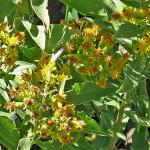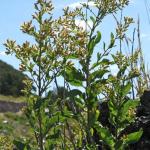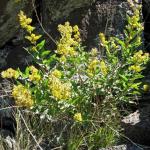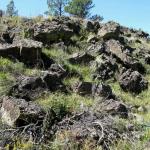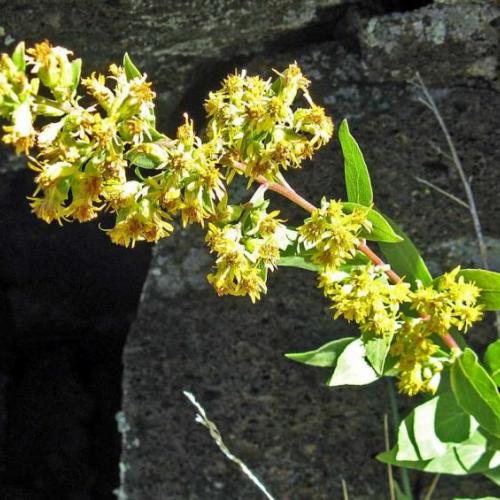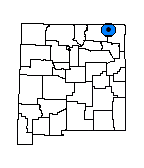Description
Perennial herb; stems ascending-erect, (4-) 8-12 dm tall, moderately puberulent and branching on the upper half; leaves densely arranged on the stems, thick textured, elliptic-lanceolate to elliptic-oblanceolate, 4-7 cm long, 12-20 mm wide, smaller into the inflorescence, basally attenuate to a subpetiolate portion 2-3 mm long, margins shallowly crenate-serrate, surfaces puberulent and minutely stipitate-glandular; inflorescence a complex cylindric-conic to pyramidal thyrse, 25-40 cm long, 15-30 (-35) cm wide, not at all one-sided; heads turbinate-campanulate, 3-5 mm wide; phyllaries in 4-5 graduated series, lanceolate to oblanceolate, apically acute, inner 5.5-6 mm long, outer about half as long; ray flowers 11-15, corollas yellow, erect, 5-7 mm long, 1-1.2 mm wide; disc flowers 5-6 mm long, corolla lobes 2.6-3 mm long; achenes 2.5-3 mm long, 0.5-0.8 mm wide, glabrous; pappus of apically acute barbellate bristles. Flowers late August through September.
Similar Species
Solidago capulinensis is similar to S. wrightii and S. petiolaris, but differs from those species in its larger stature, larger leafy inflorescence, and longer disc corollas (5-6 mm for S. capulinensis versus 3-5 mm for the other two).
Distribution
New Mexico, Union County, Capulin Volcano National Monument; adjacent Colorado, Las Animas County, Mesa de Maya region, and Pueblo County (as cultivated plants).
Habitat
Among boulders (basalt or sandstone), in canyons or on hillsides in juniper savannah and plains-mesa grassland; 1,520-2,290 m (5,000-7,500 ft).
Conservation Considerations
Surveys are needed in northeastern New Mexico and southeastern Colorado to determine the presence and abundance of this species and to determine if current land uses pose any threat. Plants at Capulin Volcano National Monument appear secure under current management.
Important Literature
Martin, W.C. and C.R. Hutchins. 1980. A flora of New Mexico, vols. 1-2. J. Cramer, Vaduz.
Cockerell, T.D.A. and D.M. Andrews. 1936. A new goldenrod from northern New Mexico. Torreya 36:35-36.
*Nesom, G.L. and T.K. Lowrey. 2011. Solidago capulinensis (Asteraceae: Astereae) redivivus. Phytoneuron 2011-24:1-22.
Semple, J.C. and R.E. Cook. 2006. Solidago, pp. 107-166 In: Flora of North America Editorial Committee (eds.). Flora of North America, Vol. 20. Oxford University Press, New York, New York.


